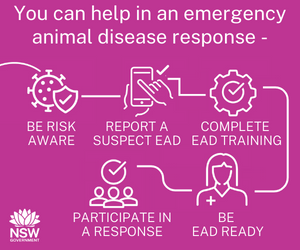Emergency Animal Disease Response: Are you prepared to get involved?
01 Aug 2023Australia has an excellent track record of preventing animal diseases from entering our country. What would happen if an emergency animal disease (EAD) outbreak did occur? What is the role of the veterinary industry?
EAD response structure
A detection of an EAD in Australia triggers a nationally agreed response structure. Depending on the size of the response, a State Coordination Centre (SCC) and one or more Local Control Centres (LCC) would be established in the affected jurisdiction.
Engaged personnel are managed at each of the centres under an organised structure. The structure used in an EAD response, the Australasian Inter-service Incident Management System (AIIMS), is used by all emergency services to manage natural disaster and other emergencies (flood, fire, storms etc.).
Role and engagement in a response
For any response, it is essential to have personnel engaged that are familiar with the local area. Veterinary professionals may be engaged in coordination roles or in operational (on the ground) activities. Most veterinarians in an EAD response are likely to be contracted in a field team undertaking activities such as:
- Disease surveillance e.g. examining animals and collecting diagnostic samples
- Vaccination or treatment programs
- Animal welfare assessments
- Humane destruction of infected or susceptible animals
- Biosecurity and quarantining activities
There are two ways that veterinary professionals may be engaged during a response:
- As a government employee - directly engaged by government on either a temporary or casual basis.
- As a contractor – directly contracted as an individual or as a company (i.e., veterinary practice) by government for specific services to support the response.
Both are paid positions with differing employment conditions.
Why get involved?
EAD responses can provide a new professional challenge, each response is different and there is always something new to learn. It can be extremely rewarding to know your contribution has made a difference to the welfare of animals and the community, and in some cases, helped avoid major economic losses for the affected industry.
Veterinary practices, particularly those in rural communities that service livestock, may suffer a drastic reduction in work during a significant EAD response due to movement restrictions. Participating in a response may help to offset income losses suffered by the practice and, importantly is likely to help minimise the impact of the disease, allowing for quicker recovery from the outbreak.
All veterinary professionals are encouraged to participate in emergency response training as not all responses are the same. If you are interested in participating in an EAD response further information, resources and training are available.
For further information on EAD response and upcoming events in your state or territory contact your jurisdiction’s Department of Agriculture/Primary Industries. NSW Department of Primary Industries also has a list of EAD training and resources on their information for vet’s page. Just follow the link to find out more. (https://www.dpi.nsw.gov.au/biosecurity/animal/info-vets)
If you would like to be kept up to date on EAD preparedness and response activities in NSW email biosecurity.vetinfo@dpi.nsw.gov.au.

